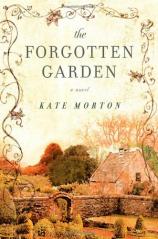The Forgotten Garden
Review
The Forgotten Garden
I’m crazy about fairy tales. Always have been, always will be. But I don’t mean perky animated movies like The Little Mermaid; I mean the eerie, ambiguous narratives of Hans Christian Andersen and the Brothers Grimm, or the late 19th-century retellings found in Andrew Lang’s Fairy Books. These stories --- evoked explicitly in Kate Morton’s THE FORGOTTEN GARDEN --- are emotionally complex, mixing terror with magic, cruel fate with happy endings. (If the success of Stephenie Meyer’s vampire books is any indication, readers young and old still take pleasure in being scared out of their wits.)
This is not to say that THE FORGOTTEN GARDEN will shiver your bones. It’s much more benign than that. Still, there is a mystery at its heart: Why was a four-year-old girl apparently abandoned by her parents in 1913 and left alone on a ship bound from London to Australia?
To answer that question, Morton constructs a generation-spanning chronicle of three women. First is a Victorian fairy tale author named Eliza Makepeace (it’s hard to believe she didn’t exist, given the quality of the three stories included in the book). Her well-born mother runs off with a seaman, is disowned by her family, and dies of consumption, leaving her daughter to the tender mercies of the evil Swindells (a couple straight out of Dickens) in fog-shrouded, crime-ridden turn-of-the-century London. Eliza, who from an early age loves to spin stories and play Jack the Ripper in the mists, is eventually tracked down by her mother’s family and delivered to their Cornwall estate, Blackhurst Manor. There she finds a repressive aunt; a vague, creepy uncle --- but, on the brighter side, also a hidden cottage and garden that become her private preserve, and a young invalid cousin, Rose, who becomes well with the help of Eliza’s loyalty, strength and active imagination. (If this sounds strangely like THE SECRET GARDEN, it is. Morton cleverly makes Frances Hodgson Burnett a guest at a Blackhurst garden party, where she is inspired by Rose and Eliza’s story to write her classic novel.)
The second thread is Nell Andrews, the perplexing abandoned child. When the ship reaches its Queensland, Australia, destination, she is found by the harbormaster and raised by him and his wife; only when she turns 21 is she told that she isn’t their child. After this shock, Nell turns strange and withdrawn. But in 1975, prompted by the contents of the small white suitcase that was found with her on the dock --- notably, a beautifully illustrated book of fairy tales by Eliza Makepeace --- she sets out to solve the conundrum of her true origins. She ends up in Cornwall, where she buys Eliza’s former cottage and garden. She intends to return and make her life there, but something prevents her.
That something is strand three, Cassandra, Nell’s granddaughter. Nell is widowed and estranged from her daughter, Lesley, who rather unceremoniously dumps her 10-year-old on mom. Cassandra grows up with Nell, shares her work at the antiques stall, and in 2005 --- 30 years after Nell’s journey to Cornwall --- keeps a vigil at her grandmother’s deathbed. When Cassandra, who has her own past losses to contend with, discovers that she has inherited Cliff Cottage, as the Cornwall hideaway is known, she in turn goes to England to play detective.
Even summarizing these stories lucidly is difficult, so you can imagine how hard it was to write them (Morton must have resorted to some sort of chart). For the most part the triple-pointed design of the book is successful. It’s good to have one of the themes of the novel --- the overlay of memories; the way the mind mixes fact and fiction --- so well supported by its structure.
What isn’t good is that echoes of other books are so loud in THE FORGOTTEN GARDEN (I had the same difficulty with Morton‘s first novel, THE HOUSE AT RIVERTON, which was straight out of Daphne Du Maurier). It’s as if she has absorbed her favorite novels too well; here there are intimations not only of Dickens and Hodgson Burnett, but of Wilkie Collins, Howard Pyle and Du Maurier (again). In her acknowledgments Morton pays tribute to children’s book authors and says this book is partly “an ode to them” --- but she fails to make the material her own. Too often it reads more like a pastiche of other people’s styles and ideas. And although it’s pleasantly written, there are a lot of rather formulaic ladies’-novel conventions: beautiful heroines with red hair, a handsome stranger showing up at the right moment, mistaken identities, gossipy local historians, an old seadog with a peculiarly accurate memory….
Yet I do treasure --- and share --- Morton’s passion for old-fashioned children’s literature and book illustration. In Eliza Makepeace’s tales, which have exactly the proper cadence and timelessness, this inspiration comes through splendidly. I just wish there had been more in THE FORGOTTEN GARDEN that emerged from that deeper place in Morton’s imagination.
But if it’s atmospheric entertainment you want, this is a knockout. Morton, like her heroine Eliza, has the storyteller’s touch. Filled with romance, tragedy and luscious period detail, the novel would make a rip-roaring miniseries. Despite its length, it’s suspenseful enough to keep you coming back for just one more chapter (though your lids are heavy) before you turn out the light.
Reviewed by Kathy Weissman on January 22, 2011
The Forgotten Garden
- Publication Date: April 7, 2009
- Genres: Fiction
- Hardcover: 552 pages
- Publisher: Atria
- ISBN-10: 1416550542
- ISBN-13: 9781416550549










